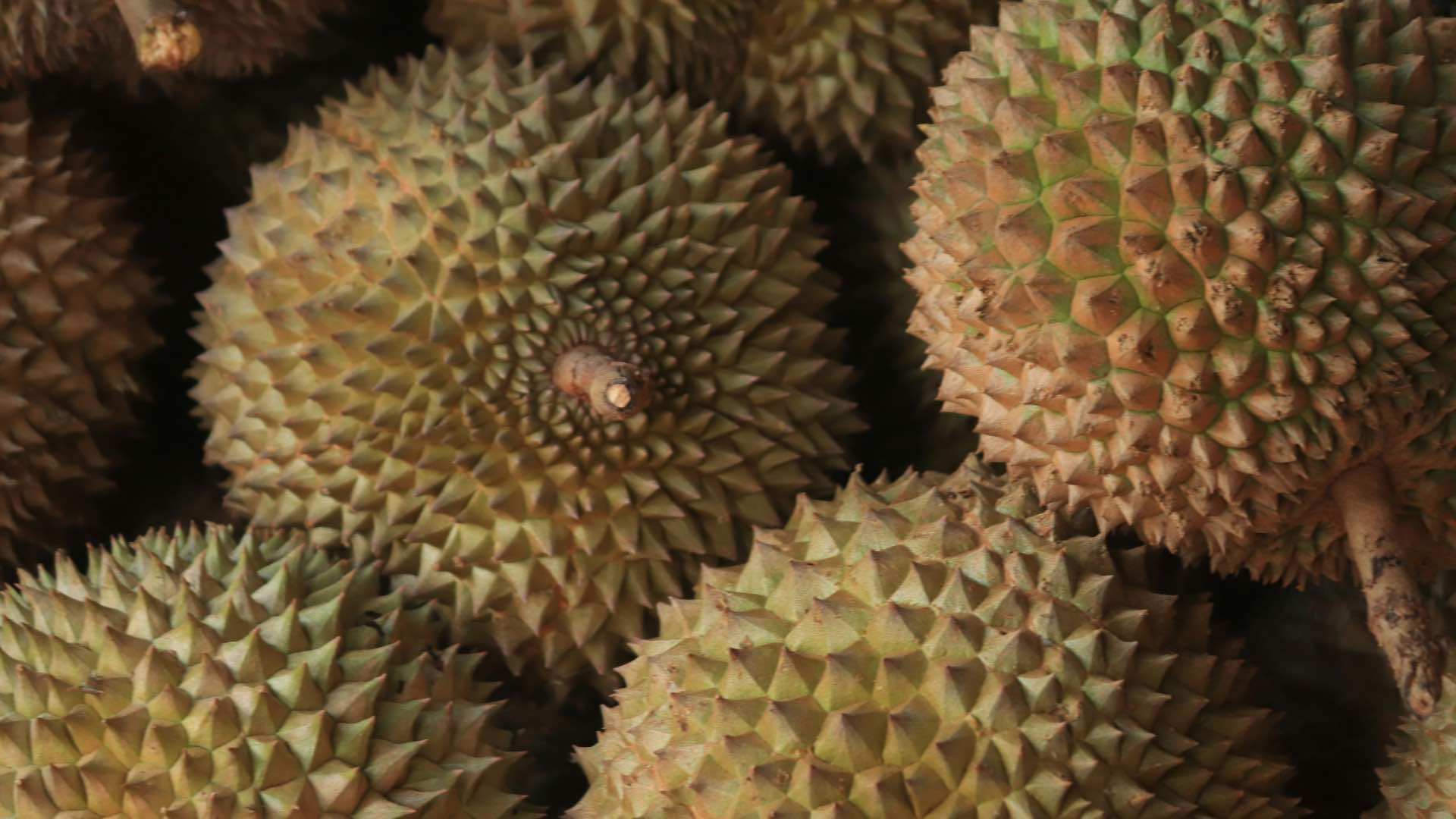Durian: The King of Fruits + Its Benefits

If you’ve traveled anywhere in Southeast Asia, you may be familiar with the durian fruit and its polarizing effect. So polarizing, in fact, taxis are often signed with “no durian” graphics, a nod to its potent and often unpleasant smell. It’s also known for its spiky exterior and unique flavor. And perhaps lesser known, especially in the Western world, durian is a powerhouse of nutrition and offers numerous health benefits. It’s an incredible superfood with a delicious flavor profile.
What Is Durian Fruit?
Durian (Durio zibethinus) is a tropical fruit native to Malaysia and Indonesia. It's a member of the Malvaceae family, which also includes hibiscus and okra (also some of my favorite superfoods). The fruit is characterized by its distinctive odor, often compared to rotten eggs or gasoline (yum…), and its thorny, green skin. The flesh of the durian is creamy and sweet, with a flavor that's often described as caramel-like. Talk about a rough exterior!
The Magnificent Benefits Of Durian
Durian is often referred to as the "King of Fruits" in Southeast Asia, and for good reason. This fruit is packed with nutrients and offers numerous health benefits.
Impressive Nutrition Profile
Fiber Content: A Whopping 20% of Daily Value
According to the United States Department of Agriculture (USDA), 1 cup of raw, pure durian pulp indeed provides a significant amount of dietary fiber. However, the exact percentage of Daily Value (DV) may vary depending on the source and specific data.
According to the United States Department of Agriculture (USDA), 1 cup of raw durian pulp contains approximately 5.3 grams of dietary fiber. The recommended Daily Value for fiber is 25-30 grams per day for adults. Therefore, 1 cup of durian pulp would provide around 18-21% of the recommended daily intake of fiber, making it a significant contributor to meeting daily fiber needs.
Other Key Nutrients in Durian Fruit
In addition to its impressive fiber content, durian is an excellent source of various essential vitamins, minerals, and antioxidants. Here are some of the key nutrients found in 1 cup of raw durian pulp:
- Fiber: 5.3g (21% of the Daily Value)
- Vitamin C: 33.6mg (44% of the Daily Value)
- Vitamin B6: 0.3mg (15% of the Daily Value)
- Folate: 45.5mcg (11% of the Daily Value)
- Potassium: 436mg (12% of the Daily Value)
- Manganese: 0.3mg (15% of the Daily Value)
- Copper: 0.2mg (10% of the Daily Value)
Support of Healthy Blood Sugar Levels
The fiber and antioxidants in durian may help slow the absorption of sugar into the bloodstream, supporting healthy blood sugar levels. This makes durian a great choice for those with diabetes or prediabetes.
Promotion of Healthy Gut Bacteria
Durian contains prebiotic fibers that feed the good bacteria in the gut, promoting a healthy gut microbiome. This can lead to improved digestion, boosted immunity, and even mental clarity.
Inflammation Reduction
The antioxidants and polyphenols in durian have been shown to have anti-inflammatory properties, which may help reduce inflammation and alleviate symptoms associated with conditions like arthritis.
Risk Factors
While durian is generally considered safe to eat, there are some potential risk factors to be aware of:
- Allergies: some people may be allergic to durian, so start with a small amount and monitor for any adverse reactions
- High calorie count: durian is relatively high in calories, so moderation is key
- Interaction with medications: durian may interact with certain medications, such as blood thinners, so consult with your healthcare provider before consuming
- Interaction with alcohol: it’s best not to consume durian with or near the time of alcohol consumption. (Although if you ask me it’s best not to consume alcohol much at all anyway!)
Eating + Cooking Durian
Durian can be enjoyed in a variety of ways:
- Fresh: scoop out the flesh and enjoy as is
- Smoothies: blend with your favorite fruits and milk for a creamy treat
- Desserts: use durian in place of traditional fats like butter or oil in baked goods
- Savory dishes: add durian to curries or stews for a unique flavor boost
An Easy Durian Ice Cream Recipe
Ingredients:
- 2 cups durian flesh
- 1 can full-fat coconut milk
- 1/4 cup honey or maple syrup
- 1/4 teaspoon salt
Instructions:
- Blend all ingredients in a blender or food processor until smooth.
- Pour into an ice cream maker and churn according to the manufacturer's instructions.
- Freeze for at least 2 hours before serving.
- Enjoy your nutritious treat!
Food Is Just One Step Towards Healing
While durian is an incredible superfood, it’s hard to come by in the Western world and even if you find it––durian alone will sadly not heal the entirety of your health problems.
For dedicated nutritional support by a team of functional medicine practitioners who focus on food as medicine, schedule a telehealth consult today.
Nope! Jackfruit and durian are not the same. While both are tropical fruits native to Southeast Asia, they belong to different families and have distinct characteristics. Jackfruit (Artocarpus heterophyllus) is a member of the breadfruit family, with a green, prickly exterior and a starchy, slightly sweet flavor. Durian (Durio zibethinus) is a member of the Malvaceae family, known for its thorny, green skin and creamy, sweet flesh. Although both fruits are often described as having a strong odor, they have distinct flavor profiles and textures.
Choosing a ripe durian can be a bit tricky, but here are some tips:
- Smell: A ripe durian will have a strong, pungent aroma that's often compared to rotten eggs or gasoline. If it doesn't have a strong smell, it may not be ripe yet.
- Color: A ripe durian will have a yellow or brownish tint around the stem, and the skin may be slightly soft to the touch.
- Squeeze: Gently squeeze the durian around the middle. A ripe durian will be slightly soft and yielding, but still firm enough to hold its shape.
- Stem: Check the stem end of the durian. A ripe durian will have a slightly indented stem, indicating that it's ready to eat.
Durian is banned in some public places in Southeast Asia, particularly in Singapore, Malaysia, and Indonesia, due to its strong odor. The smell of durian is often considered pungent and overwhelming, and some people find it unbearable. In Singapore, for example, durian is banned on public transportation, many taxis, in hotels, and in many restaurants due to complaints about the smell.
Start Your Health Journey Today
FUNCTIONAL MEDICINE CONSULTATIONS FOR PEOPLE AROUND THE WORLD
The information on this website has not been evaluated by the Food & Drug Administration or any other medical body. We do not aim to diagnose, treat, cure or prevent any illness or disease. Information is shared for educational purposes only. You must consult your doctor before acting on any content on this website, especially if you are pregnant, nursing, taking medication, or have a medical condition.
Our content may include products that have been independently chosen and recommended by Dr. Will Cole and our editors. If you purchase something mentioned in this article, we may earn a small commission.

BY DR. WILL COLE
Dr. Will Cole, DNM, IFMCP, DC is a leading functional medicine expert who consults people around the globe, starting one of the first functional medicine telehealth centers in the world. Named one of the top 50 functional and integrative doctors in the nation, Dr. Will Cole provides a functional medicine approach for thyroid issues, autoimmune conditions, hormonal imbalances, digestive disorders, and brain problems. He is also the host of the popular The Art of Being Well podcast and the New York Times bestselling author of Intuitive Fasting, Ketotarian, Gut Feelings, and The Inflammation Spectrum.

Gut Feelings
Healing The Shame-Fueled Relationship
Between What You Eat And How You Feel
